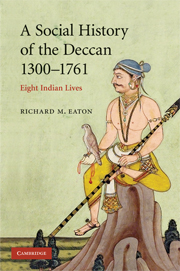Book contents
- Frontmatter
- Introduction
- 1 Pratapa Rudra (R. 1289–1323): the demise of the regional kingdom
- 2 Muhammad Gisu Daraz (1321–1422): Muslim piety and state authority
- 3 Mahmud Gawan (1411–1481): Deccanis and Westerners
- 4 Rama Raya (1484–1565): élite mobility in a Persianized world
- 5 Malik Ambar (1548–1626): the rise and fall of military slavery
- 6 Tukaram (1608–1649): non-brahmin religious movements
- 7 Papadu (fl. 1695–1710): social banditry in Mughal Telangana
- 8 Tarabai (1675–1761): the rise of Brahmins in politics
- Select bibliography
- Index
- Plate Section"
- References
4 - Rama Raya (1484–1565): élite mobility in a Persianized world
Published online by Cambridge University Press: 28 March 2008
- Frontmatter
- Introduction
- 1 Pratapa Rudra (R. 1289–1323): the demise of the regional kingdom
- 2 Muhammad Gisu Daraz (1321–1422): Muslim piety and state authority
- 3 Mahmud Gawan (1411–1481): Deccanis and Westerners
- 4 Rama Raya (1484–1565): élite mobility in a Persianized world
- 5 Malik Ambar (1548–1626): the rise and fall of military slavery
- 6 Tukaram (1608–1649): non-brahmin religious movements
- 7 Papadu (fl. 1695–1710): social banditry in Mughal Telangana
- 8 Tarabai (1675–1761): the rise of Brahmins in politics
- Select bibliography
- Index
- Plate Section"
- References
Summary
Prince Ibrahim [of Golkonda], accompanied by Saiyid Hayy, Hamid Khan [an Ethiopian], … and Kana-ji, a Brahmin, besides a few personal attendants, left the camp of [Sultan] Qasim Barid Shah [of Bidar] and proceeded to Vijayanagara. On his arrival, the Prince was received according to his rank and treated with the utmost respect and attention … At some former period Malik 'Ain al-Mulk Gilani, having offended [Sultan] Ibrahim 'Adil Shah [of Bijapur], left his service and entered that of Rama Raya, with four thousand cavalry. 'Ain al-Mulk had on many occasions so distinguished himself by his bravery that the Raja [Rama Raya] used to call him brother.
Tarikh-i Muhammad Qutb Shah (1617)THE YEARS 1510–12
In the above extract, the chronicler alludes to a number of men who migrated from the northern to the southern Deccan in the first half of the sixteenth century. By this time the Bahmani Sultanate had fractured into five successor-states, including the above-mentioned Golkonda, Bidar, and Bijapur (see Map 4). The men – a prince, a Saiyid, an Ethiopian, a Brahmin, and a high-ranking Westerner – found refuge and even patronage in the sprawling metropolis of Vijayanagara, or “City of Victory,” the capital of the great kingdom of the same name that had dominated the southern Deccan since 1347.
Notices that casually record internal migrations such as these might seem unremarkable. In fact, though, they challenge us to rethink stereotypes found in much modern history-writing about Vijayanagara, a state often cast as a bastion of Hinduism against an advancing tide of Islam from the north.
Keywords
- Type
- Chapter
- Information
- A Social History of the Deccan, 1300–1761Eight Indian Lives, pp. 78 - 104Publisher: Cambridge University PressPrint publication year: 2005



